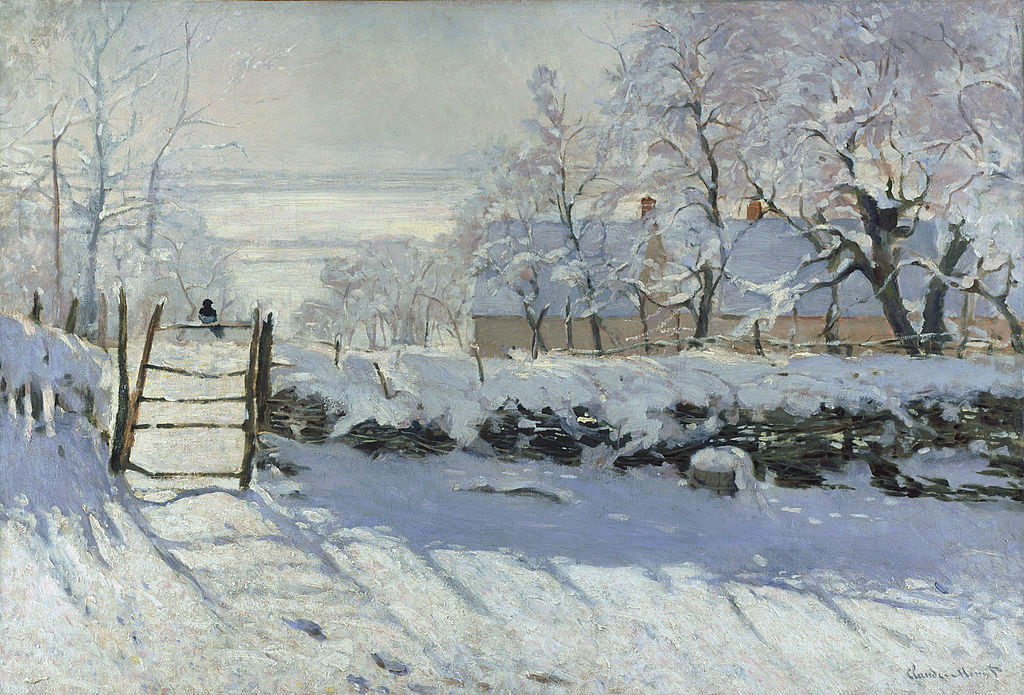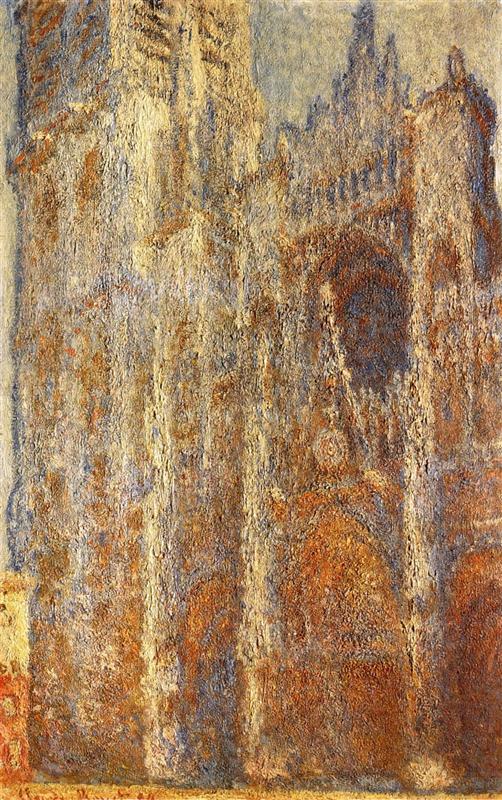
Paul Cézanne once said: “Monet is just an eye, but my God what an eye”, and it’s easy to see what he meant. When looking at this painting, “The Magpie”, one is overwhelmed with the sheer variation of colour in something as self-evidently white as a field of sunlit snow. It is less visible in reproduction, but luckily it is now available on the Google Art Project website, where you can zoom in to see all the details (it’s still not the same that seeing the original, but there is a bonus: no museum guards to warn you sternly away the moment you step closer to the painting than their rules allow).
But was it really Monet’s eye that just happened to have more sensitivity to colour than most of us are born with?
I am not sure how literally Cézanne meant his remark to be understood, but one often encounters a somewhat overly simplistic reduction of colour vision to the sensitivity of the eye, and its individual mix of photoreceptors. Had it been so simple, each of us would just have to be content with what we are genetically endowed with — there seem to be no way to change this mix of photoreceptors. Yet, with possible exception of some cases of colour-blindness, the very experience of looking at this painting shows the beholders that it’s not their eyes that usually prevent them from seeing these nuances of colour in snow — because, after all, we do see them in the painting, don’t we? And this means our eyes are capable of perceiving this variation — but we don’t have access to this ability most of the time. Why? And is it possible to change this?
Eric Kandel writes in his book, “The Age of Insight: The Quest to Understand the Unconscious in Art, Mind, and Brain, from Vienna 1900 to the Present”:
“The brain’s Creativity is evident in the visual system’s ability to reveal the same picture under strikingly different conditions of light and distance. As we move from a brightly lit garden into a dimly lit room, for instance, the intensity of the light reaching the retina may decrease a thousandfold. Yet in the dim light of the room, as in the bright light of the sun, we see a white shirt as white and a red bow tie as red. We see the bow tie as red because the brain is interested in acquiring information about the constant characteristics of an object, in this case its reflectance. How is this accomplished? The brain adjusts for the changes in light; it recomputes the colour of the tie and of the shirt to ensure that those critical identifying features are maintained under a wide variety of circumstances.”

Obviously, all these creative adjustments happen well below the threshold of consciousness: one will see snow as uniformly white because that’s what their brain is interested in. And it has a point: it probably is (or at least was) much more essential for survival to recognise snow as snow (as opposed to, say, earth or asphalt) than to get immersed in all the nuances of light and colour. But Claude Monet spent his long painting life unrelentingly undoing this specific aspect of the brain’s unconscious creativity — for himself and for us. That’s what his famous series (his haystacks, Waterloo Bridge, Rouen Cathedral) are all about — seeing (and showing) how breathtakingly different the same thing looks from one moment to another.
But what is the point of undoing the evolution’s hard work of fine-tuning human brains for perception of colour constancy?
Here is the rub: in presenting us with recomputed uniform colours, however useful this might be in some circumstances, the brain, by the same token, robs us of one of the purest delights this life has to offer, of the pleasure of witnessing, moment to moment, the glorious interplay of light and colours all around us. Could it be, then, that Claude Monet’s work is not undoing the evolution’s work, but rather continuing it, pushing it forward? Now that the immediate pressures of survival are not that pressing anymore, wouldn’t it be grand to adjust the vision system of the brain to make our life more joyful and (literally) more colourful?
Let’s have a closer look at how this system is organised. Kandel writes:
“Vision <…> begins in the eye, which detects information about the outside world in terms of light. The lens of the eye focuses and projects a tiny, two-dimensional image of the outside world onto the retina, a sheet of nerve cells covering the back of the eye. The data emerging from specialized cells in the retina resemble the visual world in the same way that the pixels in the image on your laptop computer resemble the actual image that you see on the screen. Both the biological and the electronic system process information. The visual system, however, creates representations in the brain (in the form of neural codes ) that require far, far more information than the modest amount the brain receives from the eyes. That additional information is created within the brain. Thus, what we see in “the mind’s eye” goes dramatically beyond what is present in the image cast on the retina of our real eye.”
Kandel emphasises that the information on the retina is insufficient for creating an image in the brain, but what’s important for us here is the opposite: it is, at the same time, a much richer information about light and colour than what will eventually reach the level of consciousness. These “raw data” are available to the brain (if not necessarily to the conscious mind). This conclusion coincides with what we have learned from looking at Monet’s painting: I see more colours in Monet’s snow than I would have seen in the real-life snow on the same day. The context of looking at a painting — as opposed to freezing on a snowy day and dreaming of a cup of hot tea or mulled wine — somehow changes the way my brain processes all these neural codes, so that I get a better, more direct conscious access to the raw data of my eyes.
How does the brain recompute these raw data? It seems to be rather a complicated and multilevel process; I don’t know about you, but just Kandel’s list of brain regions involved makes me a bit giddy, and this is just a short summary of what is known:
“The nerve cells that process visual information are grouped into hierarchical relays that send information along one of two parallel pathways in the visual system. These relays begin in the retina of the eye, go on to the lateral geniculate nucleus of the thalamus, continue to the primary visual cortex in the occipital lobe, and then to some thirty additional areas in the occipital, temporal, and frontal lobes of the cerebral cortex. Each relay performs a particular transformation process on the incoming information. ”
One of these parallel pathways has to do with what we see (including colour), the other determines where these objects are located. For now, we are interested only in the first one, and here is what happens when its information reaches the higher regions of the brain:
“<…> it is reappraised. This top-down reappraisal operates on four principles:
- disregarding details that are not behaviorally relevant in a given context;
- searching for constancy;
- attempting to abstract the essential, constant features of objects, people, and landscapes;
- and, particularly important, comparing the present image to images encountered in the past.”
I have added bullet points to Kandel’s plain list of four principles, because they all seem very important in my quest to transform the vision system of my own brain. To begin with, the concept of “behavioural relevance in a given context” offers a clear explanation of why we see in a painting what we usually miss “in real life”: the painting creates a “sanctified place” where other behavioural concerns are suppressed by the very process of seeing. I imagine it somehow sends a “top-down” signal to the brain to pay attention to nuances rather than to search for constancy and for familiar objects.
A different — but not less rewarding — change of context happens in the very process of painting, especially en plein air. I know from experience that my colour vision changes perceptibly between the “in-painting” mode and the “default”, outside-painting mode (it is possible, though, to switch to the “in-painting” mode of paying attention even outside the context of painting, and enjoy it for its own sake).
Lilla Cabot Perry recalls in her reminiscences of Claude Monet (in “The American Magazine of Art”, March 1927) that he once said to her:
“When you go out to paint, try to forget what objects you have before you, a tree, a house, a field or whatever. Merely think, here is a little square of blue, here an oblong of pink, here a streak of yellow, and paint it just as it looks to you, the exact colour and shape, until it gives your own naive impression of the scene before you.”
She also recalls that he wished to have been born blind, and then suddenly gain sight, so he could paint without knowing what are the objects before him. It sounds to me like he tried to consciously switch off the third principle in Kandel’s list, that is, to train his unconscious vision system not to search for “essential features” of objects and people, at least not in the “in-painting” mode. Or maybe that is impossible — I don’t know — but the system can certainly be trained to focus on a completely different range of “objects”: these squares of blue, and oblongs of pink, and streaks of yellow.
Be it as it may, the last principle — the relevance of past visual experiences — gives us hope that once we have seen colours in snow (instead of always seeing it as plain white), the brain may begin to “get” that that’s also interesting and rewarding, and so gradually learn to make more colours from the raw data of the eye accessible to the conscious mind.
This, I believe, is how Claude Monet changes the unconscious vision system of the beholder — and that’s how he has changed our reality.
[share title=”If you’ve enjoyed reading this post, please consider sharing it with your friends!” facebook=”true” twitter=”true” google_plus=”true” linkedin=”true” pinterest=”true” reddit=”true” email=”true”]